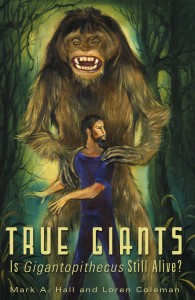
February 17, 2011

True Giants: Is Gigantopithecus Still Alive? by JT Lindroos
If you don’t think the 8-foot Sasquatch roaming in the Pacific Northwest is big enough a beast for you, then this here title should set you straight: True Giants: Is Gigantopithecus Still Alive? A true giant, as defined by the esteemed authors, Loren Coleman and Mark A. Hall, is both bigger and badder than its bigfooted Northwest sibling.

True Giants: Is Gigantopithecus Still Alive?
From the Biblical stories, through Native American legends to modern-age sightings, tales of giants have been pervasive and persuasive. They’ve been used to sell newspapers, terrify naughty children, name fledgling sports teams and mined as fodder for all types of fantastic fiction.
Yet curiously, the reports are persistently uniform, from massive hairy size to the conical shape of the head to the enormous, four-toed footprints. These wild animals have been said to have rudimentary grasp of speech, the ability to utilize tools, and the strength to crush men’s heads like overripe tomatoes. Interestingly, Slavomir Rawicz described uncannily similar creatures in the bestselling The Long Walk: The True Story of a Trek to Freedom, although his encounter with these abominable snowmen suggested them to be “only” 8 feet tall.
However you may feel about the reality of the subject, True GiantsGigantopithecus, one of its cousins, or some other unrecognized ape-like beast. The book doesn’t make unsubstantiated claims, but lines up a delightful parade of records and reports from all across the globe, from antiquity to current date, and drops it on your doorstep so you can take from it what you will.

You can enjoy the book as an entertaining history lesson, as a serious first peek behind the reality of an elusive creature perhaps still lurking in the vast wildernesses of our strange planet, or as a collection of folk tales and myths from the frozen tundra of Siberia to the Islands of the South Seas.
If there is a criticism to be given for the book, it lies in the appendices. Two of the seven are reprints of stories by Ivan T. Sanderson from the late 1960s. Sanderson is such an engaging storyteller that Coleman and Hall are momentarily outgunned in their own book! Of course, none of this matters to the reader, since that’s just gravy on a gourmet dinner. —
This review first appeared on www.bookgasm.com and was reproduced here with the permission of JT Lindroos.
About Loren Coleman
Loren Coleman is one of the world’s leading cryptozoologists, some say “the” leading living cryptozoologist. Certainly, he is acknowledged as the current living American researcher and writer who has most popularized cryptozoology in the late 20th and early 21st centuries.
Starting his fieldwork and investigations in 1960, after traveling and trekking extensively in pursuit of cryptozoological mysteries, Coleman began writing to share his experiences in 1969. An honorary member of Ivan T. Sanderson’s Society for the Investigation of the Unexplained in the 1970s, Coleman has been bestowed with similar honorary memberships of the North Idaho College Cryptozoology Club in 1983, and in subsequent years, that of the British Columbia Scientific Cryptozoology Club, CryptoSafari International, and other international organizations. He was also a Life Member and Benefactor of the International Society of Cryptozoology (now-defunct).
Loren Coleman’s daily blog, as a member of the Cryptomundo Team, served as an ongoing avenue of communication for the ever-growing body of cryptozoo news from 2005 through 2013. He returned as an infrequent contributor beginning Halloween week of 2015.
Coleman is the founder in 2003, and current director of the International Cryptozoology Museum in Portland, Maine.
Filed under Bigfoot, Books, CryptoZoo News, Evidence, Extinct, Eyewitness Accounts, Folklore, Footprint Evidence, Guest Blog, Malaysian Bigfoot, Pop Culture, Reviews, Sasquatch, True Giant, Windigo, Yeren, Yeti, Yowie